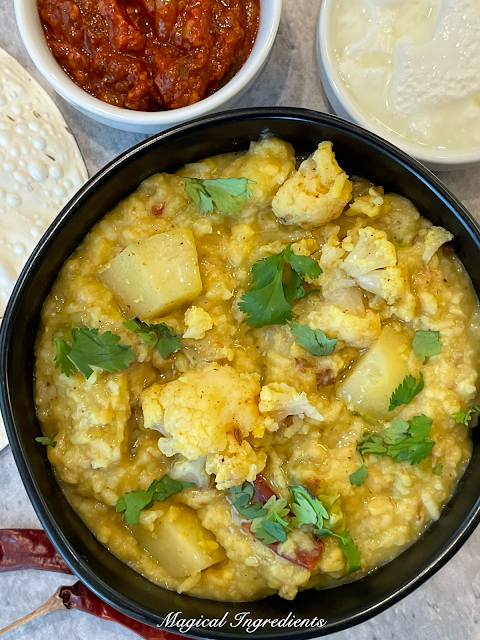This is a simple, easy, comfort food that is healthy too. This is a traditional recipe from the Bengali cuisine and this khichadi is also a part of a festive meal as it doesn’t use onion or garlic. This is also an everyday comfort food.
Khichuri (in Bengali) aka khichadi (in Hindi) is a somewhat mushy meal made with rice and lentils, drizzled and/or tempered with ghee and spice, with or without veggies. In Tamil cuisine this is called as pongal as our khichadi is a vegetable version of rava upma. This tasty bhoger khichuri is offered to the Goddess during Navrati/Kali puja and on many other occasions too. Bhog means festive food and prasad that is offered in temples and pooja. The roasting of the slightly aromatic Gobindobhog rice and dal adds to the nutty flavor in this khichuri.
This no onion no garlic khichuri is similar to our pongal (we make it for festive meals as well as for any day), though there are some differences. Similarity is that it is made with rice and split yellow moong dal. The differences are that traditional pongal doesn’t use turmeric and the spices used in this recipe, pongal is flavored with cumin and black pepper alone. Bhoger khicuri also uses vegetables like potato, cauliflower, and peas.
Though called in many names, khichadi is a simple and comforting one-pot meal that makes a great meal, for any meal. It is also soothing to the digestive system and is easy to digest for kids as well as adults. The ratio of rice to dal varies from region to region, or from home to home. Sometimes rice and dal is roasted to make pongal and it varies from home to home. Any grain could be used to make khichadi or pongal, and click here for some delicious recipes. Also, different dals and grains could be used to make a simple and nutritious comforting meal, like Turmeric Pongal and Mixed millet and Dals Khichdi.
Let’s look into the ingredients that are required to make this one pot comfort food.
Rice - In this recipe, gobindobhog rice is used. This rice is used in traditional Bengali recipes. If you do not have this, use the variety that you have on hand, preferable short grain, and not sticky rice.
Split yellow moong dal - This dal is an amazing source of proteins and is easy to digest.
Salt - Adds flavor to the khichdi.
Turmeric - Adds color to the khichdi. It also has antiinflammatory properties.
Whole cardamom - Enhances the aroma and flavor.
Bay leaves - Adds to the flavor
Cinnamon, cloves - enhances the aroma and flavor
Ghee - Adds to the flavor
Ginger - enhances digestion and adds flavor.
Cumin - This adds to the flavor and enhances digestion
Asafetida - Aids digestion
Dried red chilies - Adds to the heat
Cayenne - Adds a mild kick
Garam masala - Bengali Gorom Mashala can be added. If not, regular garam masala (devoid of garlic powder) can be used instead.
Water - To wash and cook the rice and dal.
Peas - fresh or frozen peas can be used. This adds to the protein profile.
Potatoes - Large chunks or cubes are used in this recipe as they retain their shape.
Cauliflower - medium to big florets are used in this recipe to retain their shape and texture.
Traditionally, this khichuri is cooked on stove top. This can be made in Instant Pot or pressure cooker. When using an Instant Pot or pressure cooker, make a note not to cook for a very long time as the cauliflower and potato may become mushy. Alternatively, cooked potatoes and stir fried cauliflower may be added at the end to the khichuri.
Consistency
When making khichuri, the consistency depends on personal preference. Though this khicuri is towards the porridge side, if a non-mushy version is preferred, use reduced water, and avoid adding water at the end to mush the khichuri. The khichuri thickens with time, so add water to adjust consistency.
Servings
This recipe makes 8 servings easily. It is also dependent on the individual's hunger and portion preferences.
What to serve this with?
This khichuri is a comfort food that has all the nutrition packed. It also has veggies in it. Drizzle extra ghee and serve as such. Papad or pickles can be served that would make it even special. Bengalis serve this with Bhaingan or Aloo Bhaja, similar to bajji/pakora. Try this Cauliflower pakora as a side. We prefer to have this with kochumber and a cup of yogurt.
Leftovers….
Leftovers are great to use for another meal. I make this quantity often as this will make the next day's dinner easy for me. The khicuri can be reheated in a microwave or stovetop and served. This khichuri thickens with time, add water to adjust consistency and reheat.










No comments:
Post a Comment